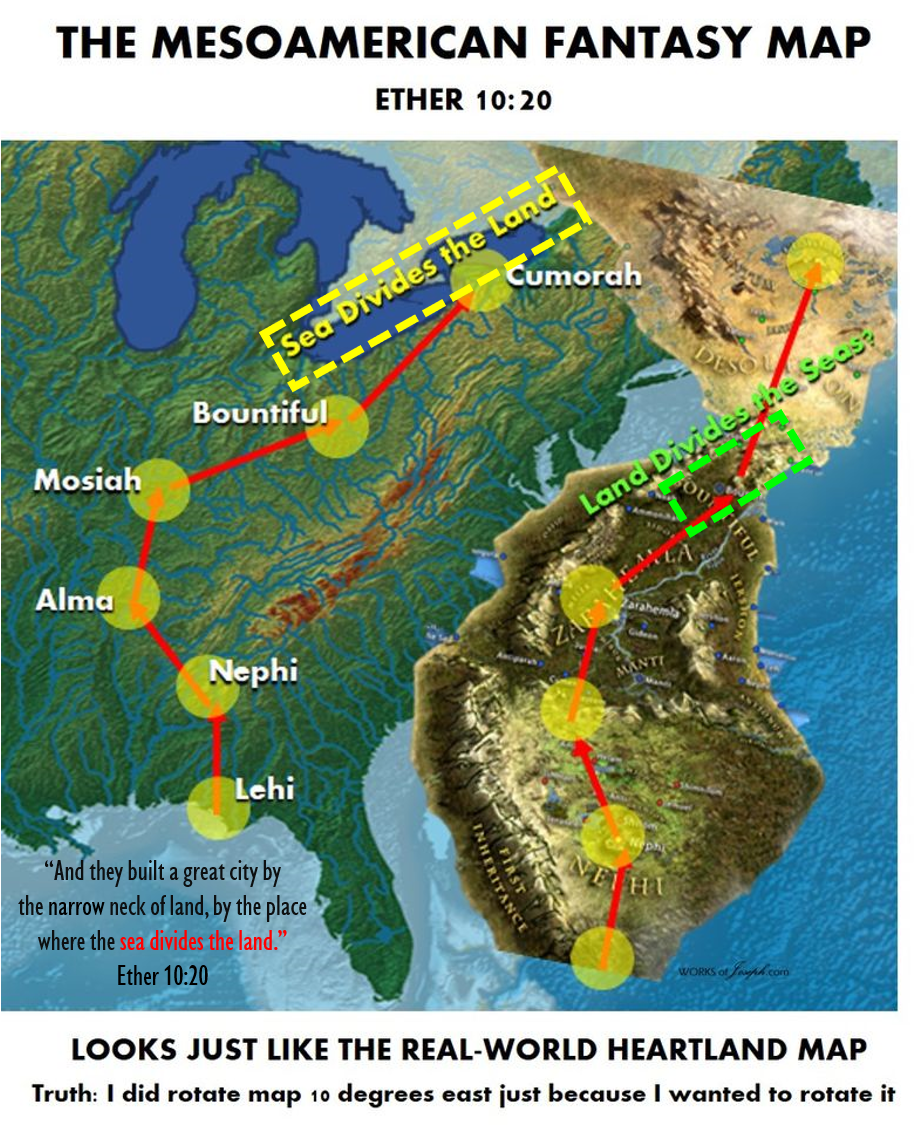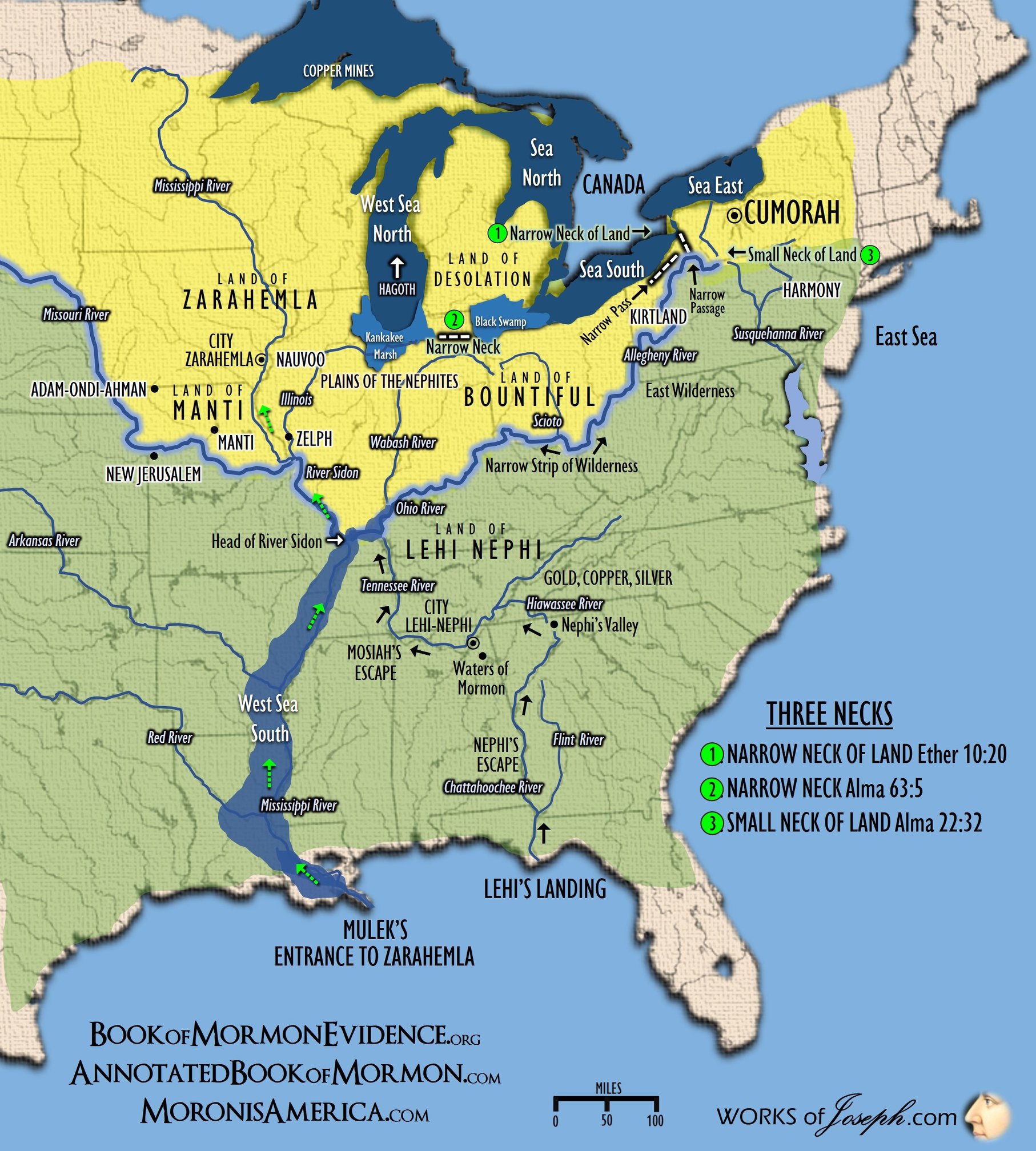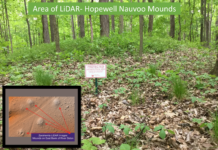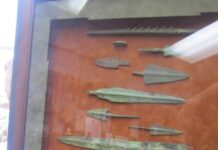Overview of Book of Mormon Geography
This article was prepared as a stand alone overview of basic information about our belief in why we believe the Book of Mormon events began in the Heartland of the United States. We understand through intermarriage and migration and many other factors, that there are today many Lamanites in North, South, and Central America, who may have some of the blood of Lehi flowing through their veins as well.
The Geography of the Nephites had to have begun somewhere, and we offer solid information on why we believe that. Yes it does matter to us where these events began. Just as it is important that we know the place of the birth of our Savior, or the place of the landing of the Pilgrims, or other historical information. We believe the Ancient culture of the Hopewell Natives in North America follows the same Nephite time-line almost exactly, and the probability of the Hopewell and the Nephites as the same race of people is amazingly possible.



Understanding a good Map and a Not so good Map
Book of Mormon Geography Overview by Jonathan Neville
“The Book of Mormon took place in North America, not Central America or anywhere else. Oliver Cowdery and Joseph Smith taught this clearly. Early Church authors, including Benjamin Winchester, speculated about a setting in Central America. Winchester wrote editorials to that effect that were published anonymously in the 1842 Times and Seasons. Ever since, people assumed, incorrectly, that Joseph wrote or approved of these editorials. Over the years, scholars developed a theory that Cumorah was in Mexico, not New York. They elaborated on their theory to the point that it became the de facto theory in the Church. But it’s wrong and I hope the historical mistake gets corrected soon.
I started my blog titled www.bookofmormonwars to explore questions of Book of Mormon historicity and geography. I’m an active member of the Church and I accept the Book of Mormon as an actual history of real people. There are a lot of active, inactive, and former members who don’t believe that. I wanted to know why. I’ve spent much of the last two years (July 2014-July 2016) focusing on the issue, and now I’m going to state my overall conclusion and thesis. After that, I will briefly summarize the history of the blog and the responses I have received.
 Many members of the Church are deeply attached to a particular setting for the Book of Mormon. If your ideas work for you—in the sense that your beliefs make the text more real for you and help you understand and apply its meaning—then that’s great. In this blog I’m simply relating the facts as I understand them, along with reasonable inferences. This understanding works for me. Your mileage may vary. Do what you think best. Many active Church members tell me it doesn’t matter where the Book of Mormon took place because it is the message (about Christ and the Gospel) that is the most important. To me, that’s a non sequitur. Granted, the message about Christ and the Gospel is the most important, but that’s not the reason we have the Book of Mormon. That message could have been communicated through modern revelation. It could also have been communicated through parables—which is exactly what many active members of the Church think the Book of Mormon is, instead of an actual history. I’m not saying active members need to be interested in Book of Mormon historicity and geography, but I am saying they need to recognize they are self-selected by their faith in the Book of Mormon. When we recognize that most members of the Church are not active, maybe we’ll recognize one reason is because they don’t accept the Book of Mormon as a literal history. I think the reason we have the Book of Mormon is (as the Title Page explains) to convince people that Jesus is the Christ, manifesting himself unto all nations.
Many members of the Church are deeply attached to a particular setting for the Book of Mormon. If your ideas work for you—in the sense that your beliefs make the text more real for you and help you understand and apply its meaning—then that’s great. In this blog I’m simply relating the facts as I understand them, along with reasonable inferences. This understanding works for me. Your mileage may vary. Do what you think best. Many active Church members tell me it doesn’t matter where the Book of Mormon took place because it is the message (about Christ and the Gospel) that is the most important. To me, that’s a non sequitur. Granted, the message about Christ and the Gospel is the most important, but that’s not the reason we have the Book of Mormon. That message could have been communicated through modern revelation. It could also have been communicated through parables—which is exactly what many active members of the Church think the Book of Mormon is, instead of an actual history. I’m not saying active members need to be interested in Book of Mormon historicity and geography, but I am saying they need to recognize they are self-selected by their faith in the Book of Mormon. When we recognize that most members of the Church are not active, maybe we’ll recognize one reason is because they don’t accept the Book of Mormon as a literal history. I think the reason we have the Book of Mormon is (as the Title Page explains) to convince people that Jesus is the Christ, manifesting himself unto all nations.
If, as I assert, the Book of Mormon is an actual history of real people, then the only explanation for it is what Joseph and Oliver said. And if it’s an actual history, then it took place somewhere—again, as Joseph and Oliver said. Ultimately, the geography depends on where Cumorah is. I suspect most members of the Church—including me—think Cumorah is in New York. Many Church members are surprised to discover that is not what most LDS Book of Mormon scholars claim. I think the scholars are wrong, and this blog explains why. Summary and thesis: This is a summary of the facts in Church history as I understand and interpret them. You may or may not have heard/read these things before, but probably you have not. Some people will disagree with me about some of the details, but my point here is not to convince anyone. I’m just explaining my thesis. I’m not including any references or detail; I’ve provided hundreds of footnotes in this blog and in my books for those interested.
 In 1829, Joseph Smith and Oliver Cowdery translated the plates Moroni deposited in the square box he constructed of stone and cement in the Hill Cumorah near Palmyra, New York. Joseph and Oliver worked in Joseph’s small home in Harmony, Pennsylvania. While they worked on the translation, Joseph received a revelation (D&C 10) that he should not retranslate the first part of the plates—the Book of Lehi. (In 1828, he had translated the Book of Lehi with Martin Harris acting as scribe, but Harris lost the manuscript.) Consequently, when Joseph and Oliver reached the end of the Book of Moroni, they were finished with those plates. D&C 10 told Joseph he’d have to translate the Plates of Nephi to replace the lost manuscript—but he didn’t have the plates of Nephi. Due to increasing persecution, Joseph and Oliver arranged to continue the work at the Whitmer farm in Fayette. Joseph gave the plates to a heavenly messenger in the form of a man. David Whitmer drove his wagon to Harmony to pick them up. On their way to Fayette, they passed the messenger on the road. David asked if he wanted a ride, but the man declined, saying he was heading for Cumorah.
In 1829, Joseph Smith and Oliver Cowdery translated the plates Moroni deposited in the square box he constructed of stone and cement in the Hill Cumorah near Palmyra, New York. Joseph and Oliver worked in Joseph’s small home in Harmony, Pennsylvania. While they worked on the translation, Joseph received a revelation (D&C 10) that he should not retranslate the first part of the plates—the Book of Lehi. (In 1828, he had translated the Book of Lehi with Martin Harris acting as scribe, but Harris lost the manuscript.) Consequently, when Joseph and Oliver reached the end of the Book of Moroni, they were finished with those plates. D&C 10 told Joseph he’d have to translate the Plates of Nephi to replace the lost manuscript—but he didn’t have the plates of Nephi. Due to increasing persecution, Joseph and Oliver arranged to continue the work at the Whitmer farm in Fayette. Joseph gave the plates to a heavenly messenger in the form of a man. David Whitmer drove his wagon to Harmony to pick them up. On their way to Fayette, they passed the messenger on the road. David asked if he wanted a ride, but the man declined, saying he was heading for Cumorah.
David had grown up in the area but had never heard of Cumorah. He turned to Joseph to inquire. When he turned back, the messenger had already left. The messenger went to Cumorah where, separate from Moroni’s stone box, there was a large underground room—a repository—containing all the records of the Nephites. Mormon had moved the plates here from the original storage place in the Hill Shim. The messenger left Mormon’s plates in the repository and retrieved the plates of Nephi. He took these to Fayette. He showed them to David’s mother before giving them to Joseph Smith. Joseph and Oliver translated the plates of Nephi (1 Nephi through Words of Mormon) in Fayette. When they finished, Oliver, David Whitmer, and Martin Harris sought permission to see the plates. The messenger brought additional records from the repository, including the plates of brass, the plates of Ether, and other plates and artifacts. He set them up in the woods. Moroni then appeared to Joseph, Oliver and David, showing them all the records.
He appeared to Martin Harris and Joseph separately, possibly showing him just some of the things Oliver and David saw. The messenger then returned all the plates and artifacts to the repository in Cumorah. Later, Joseph arranged to have eight other men view the plates. These men were all in the area of Palmyra when they saw them. Joseph and Oliver went to the repository, retrieved a set of plates (probably Mormon’s, not Nephi’s). Joseph and Oliver returned the plates to the repository. This likely happened on more than one occasion; i.e., two groups of four men each saw the plates, but they all signed a joint statement of testimony. From the time Joseph first announced he had found the plates in the Hill Cumorah, people had been digging in the hill seeking buried treasure. The Lord knew that once the statements of the witnesses were published, the treasure seekers would renew their efforts. Before Oliver Cowdery left on his mission to the Lamanites, he and Joseph, probably assisted by David Whitmer and Joseph’s brothers Hyrum and Don Carlos, moved the plates out of Cumorah to another location. Probably this was to the Hill Shim where Ammaron had originally hidden them. It took several trips by wagon, but it left the repository in Cumorah empty.
All of the men involved operated under a vow of secrecy. Oliver and some of the others did tell Brigham Young and a few other people what happened. Possibly they told Brigham where they moved the plates, but if so, this has never been discussed publicly. During Zion’s Camp, Joseph recognized the terrain as the plains of the Nephites. He wrote about it to Emma, who had been one of the original scribes. She knew what Joseph was referring to because they had discussed what Joseph learned from Moroni during his interviews, when Moroni told him all about Nephite society and showed him the people in vision. Also on Zion’s Camp, Joseph had a vision of Zelph, a warrior in the final battles who was killed and buried in Illinois. Joseph knew the Native American Indians who lived in the Great Lakes region were the descendants of Lehi’s people. He met with tribes from this area and told them their fathers had written the Book of Mormon. At various times, Joseph tried to write a history of the Church, but events were unfolding so rapidly – and he was not comfortable writing because of his limited education – that the efforts never amounted to much.
 In 1834, Oliver began writing a series of letters to W.W. Phelps, outlining the early history. Joseph assisted in the effort. Oliver wrote eight letters that were published in the Church’s newspaper, the Messenger and Advocate, in Kirtland. In Letter VII, he described the Hill Cumorah and explained that the final battles of the Nephites and Jaredites took place in the mile-wide valley west of Cumorah. Oliver didn’t claim revelation on the point; he knew it was true because Mormon had deposited the records in the hill and Oliver and Joseph had both seen them there. That’s why Joseph had his scribes copy Letter VII into his journal as part of his history (this was after Letter VII was published in the Messenger and Advocate in 1835).
In 1834, Oliver began writing a series of letters to W.W. Phelps, outlining the early history. Joseph assisted in the effort. Oliver wrote eight letters that were published in the Church’s newspaper, the Messenger and Advocate, in Kirtland. In Letter VII, he described the Hill Cumorah and explained that the final battles of the Nephites and Jaredites took place in the mile-wide valley west of Cumorah. Oliver didn’t claim revelation on the point; he knew it was true because Mormon had deposited the records in the hill and Oliver and Joseph had both seen them there. That’s why Joseph had his scribes copy Letter VII into his journal as part of his history (this was after Letter VII was published in the Messenger and Advocate in 1835).
Years later, Joseph gave express permission to Benjamin Winchester to republish the letters, including Letter VII, in the Gospel Reflector. Joseph’s brother Don Carlos also republished them in the Times and Seasons. The following year, 1842, Joseph referred to Cumorah in D&C 128. Cumorah in New York was universally understood in Joseph’s day because Joseph and Oliver taught it, and they taught it because they had been inside Mormon’s repository and had moved the Nephite records. Apart from Cumorah, which Joseph mentioned in D&C 128, and Zarahemla, mentioned in D&C 125, the Prophet never officially identified specific Book of Mormon sites. He was faced with more pressing matters, including the troubles in Missouri, the need to build the temple and introduce all the temple ordinances before he died, the thousands of immigrants coming to settle in Nauvoo, and much more. It is possible he was unable to relate what he knew to the geography passages in the Book of Mormon because the references in the text are archaic and use Hebrew parallel forms.” Jonathan Neville moronisamerica.com To purchase Jonathan’s Books visit Here Moroni’s America and here Letter VII and here Lost City of Zarahemla.

Cartoons by Val Chadwick Bagley.
Purchase his wonderful Heartland themed book here.





